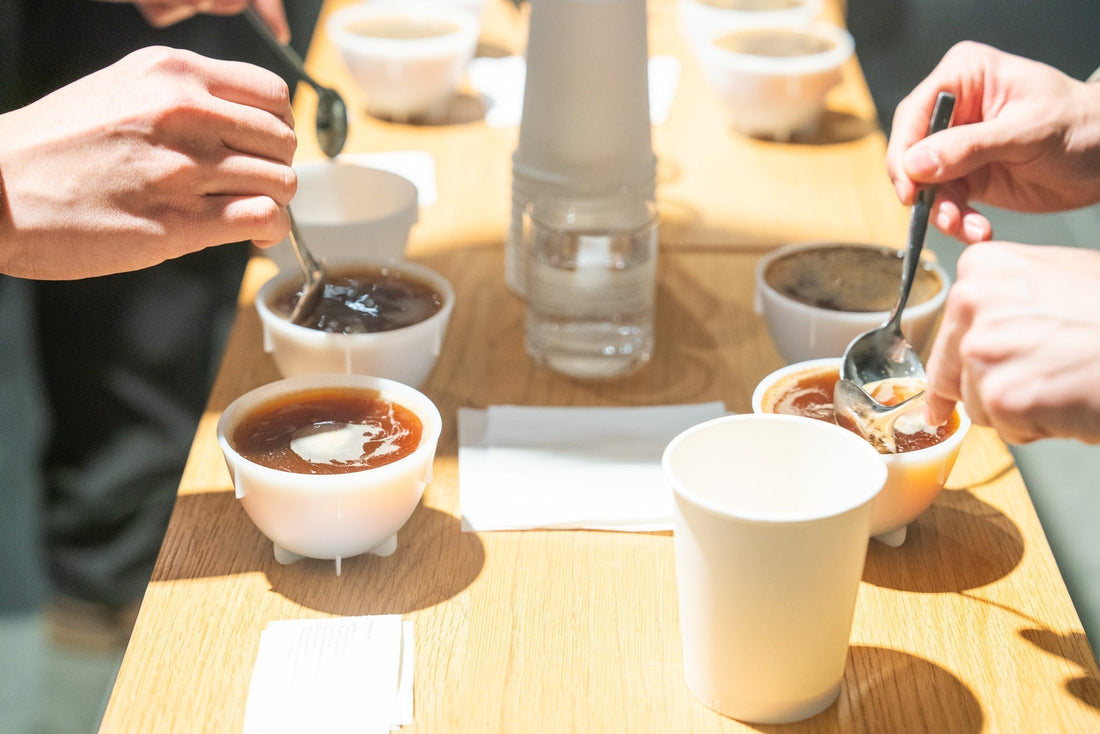
Cupping
Share
이 튜토리얼은 커피의 맛을 구분하고 표현하는 데 어려움을 겪는 사람들을 위해 설계되었습니다. 기본적인 커피 테이스팅 기법을 소개하며, 커피를 비교하면서 시음하는 것의 중요성과 연습을 통해 다양한 맛을 인지하는 능력을 강조합니다. 또한 단맛, 산미, 쓴맛을 구별하는 간단한 훈련도 포함되어 있습니다.
기본 맛 훈련
커피 맛을 느끼는 첫 단계는 다음과 같은 재료로 맛의 기본 요소를 구분하는 훈련입니다:
물, 설탕, 구연산(레몬즙), 오렌지 껍질
단맛(Sweetness): 설탕이 들어간 물을 맛보며 단맛을 인지합니다.
산미(Acidity): 레몬즙이 섞인 물을 맛보며 산미를 구별합니다.
쓴맛(Bitterness): 오렌지 껍질이나 강하게 볶은 커피를 통해 쓴맛을 경험합니다.
이 훈련의 핵심은 산미와 쓴맛을 혼동하지 않는 것입니다.
쓴맛은 일반적으로 다크 로스팅된 커피에서 느껴지며,
산미는 혀 옆면에서 느껴지는 날카롭고 상큼한 감각입니다.
커피 비교 시음
1. 2~3가지 커피를 동시에 준비해 비교 시음하는 것이 추천됩니다:
- 첫 번째 커피: 인스턴트 커피, 다크 로스트의 로부스타 품종
- 두 번째 커피: 신선하게 로스팅된 고품질 케냐산 커피 (라이트 로스트)
- 세 번째 커피: 고품질 온두라스산 커피 (카투아이 품종)
2. 시음 전: 원두를 갈아서 향을 맡아 비교해 보세요.
- 인스턴트 커피는 연한 캐러멜 향 정도이며 향이 거의 없음
- 케냐 커피는 과일 향이 강하게 느껴짐
- 인스턴트 커피는 단순한 초콜릿 향 같은 뉘앙스
핵심 테이스팅 요소
쓴맛 (Bitterness)
인스턴트 로부스타 커피: 품종과 로스팅으로 인해 매우 씀
케냐 커피: 쓴맛 거의 없음, 대신 산미가 높음
온두라스 커피: 중간 정도의 쓴맛, 산미와 균형 잡힘
산미 (Acidity)
케냐 커피: 매우 높은 산미, 신선한 과일을 연상시킴
온두라스 커피: 케냐보다는 낮지만 인스턴트보다는 높음
단맛 (Sweetness)
케냐 커피: 산미와 단맛의 균형, 잘 익은 과일과 비슷한 인상
온두라스 커피: 단맛이 두드러지고, 크리미한 질감
입안 느낌 (Mouthfeel)
인스턴트 커피: 묽고 가벼움
케냐 커피: 부드럽고 약간 오일리
온두라스 커피: 우유보다 크림에 가까운 진한 질감
애프터테이스트 (Aftertaste)
인스턴트 커피: 짧고 쓰며, 탄 맛·고무 향과 같은 불쾌한 여운
케냐 커피: 과일과 설탕 같은 상쾌한 여운
온두라스 커피: 길게 지속되는 단맛, 초콜릿·견과류 느낌
결론
커피 테이스팅에서는 쓴맛, 산미, 단맛, 질감, 애프터테이스트를 중심으로 맛을 인식하는 것이 중요합니다.
이러한 특성들을 구별하는 능력을 기르면, 서로 다른 커피를 비교하고 정확하게 묘사하는 데 큰 도움이 됩니다.
또한 테이스팅 능력을 키우기 위해서는 커피 외에도 다양한 음식과 음료를 맛보며 훈련하는 것이 좋습니다.
이것이 미각을 예민하게 하고 커피의 섬세한 향미를 더 잘 이해하는 방법입니다.
